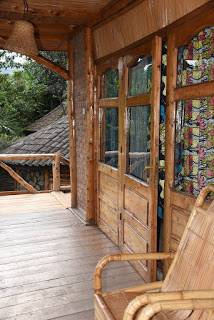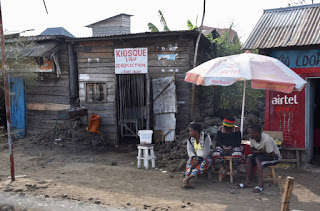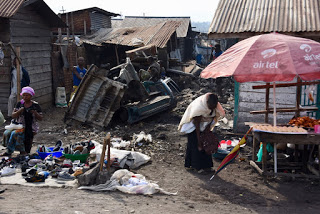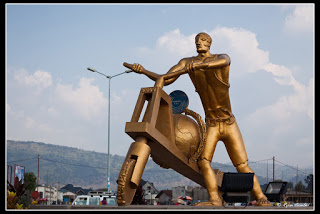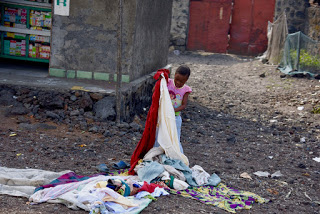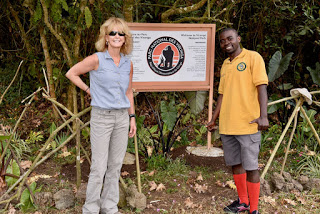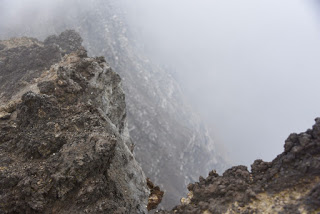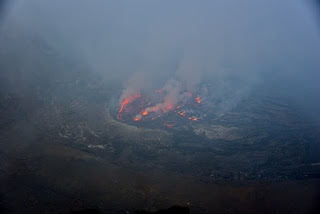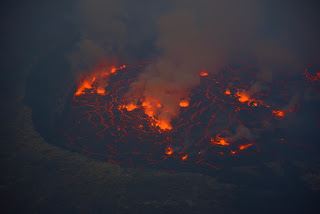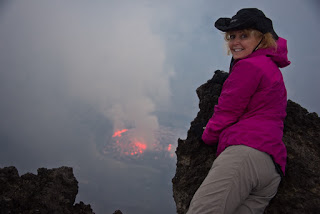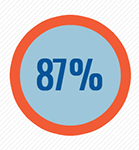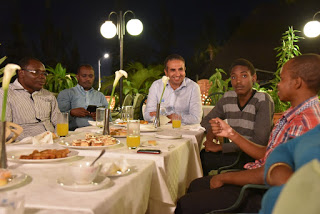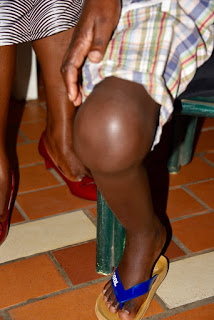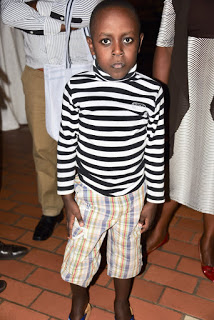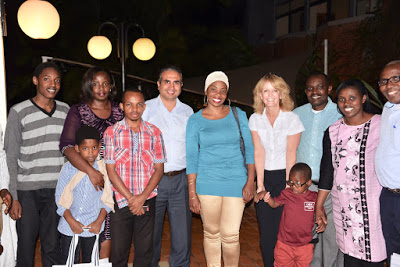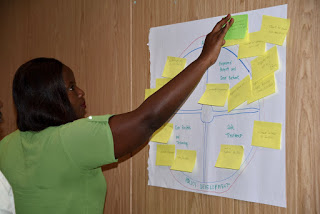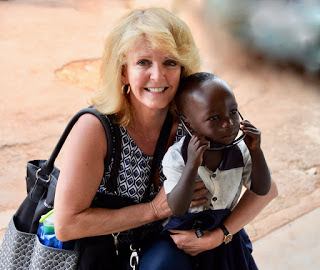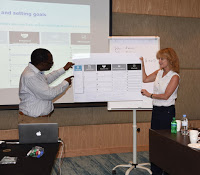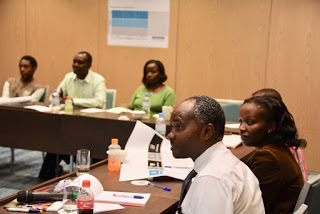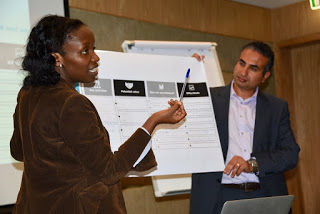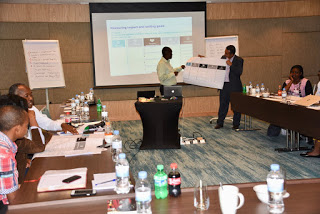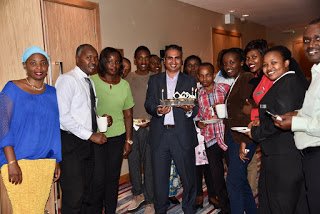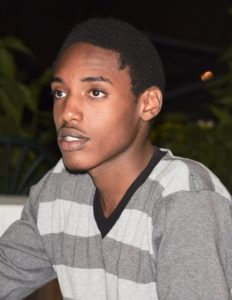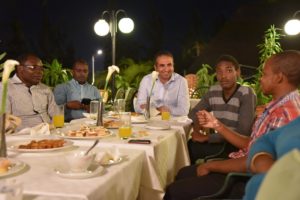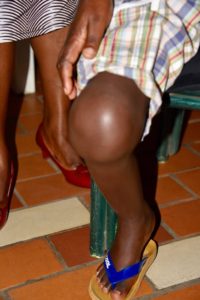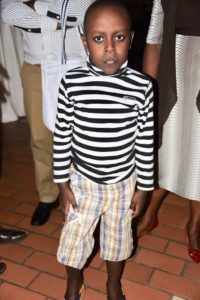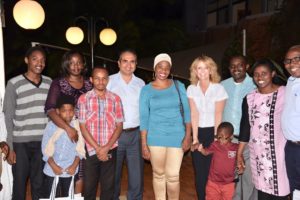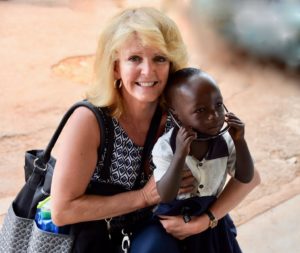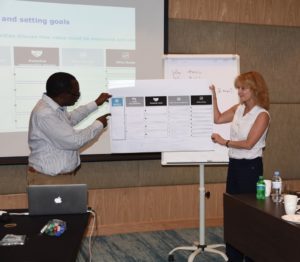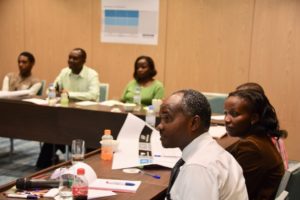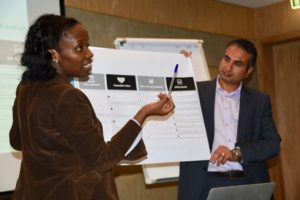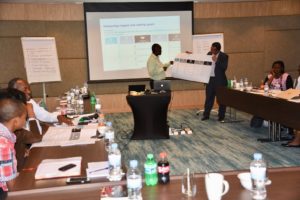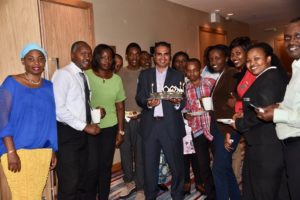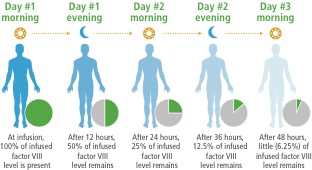La-Va Land
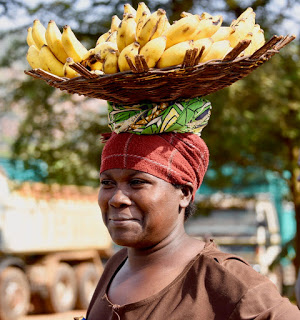
A brief respite from all things hemophilia as I share my adventure to the Nyiragonga Crater in the Democratic Republic of the Congo.
up my hiking gear, and waited in the lobby of the Mille Collines (of “Hotel Rwanda” fame). My driver Faustin arrived,
and we loaded up the jeep and took off. He was nice: clean cut, friendly, like
most Africans seem to be. We drove through Kigali, where there was a bit of Saturday
morning traffic on the narrow, two-lane road.
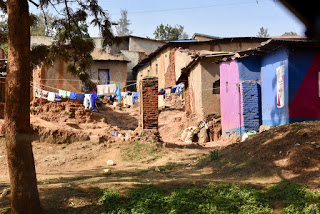
The drive was a good four hours to the Rwanda border. I looked out the window at the pink stucco houses perched on the
rolling hills of Kigali to my right; to my left, more tropical pink and
turquoise blue painted homes on top of red dirt. Despite the dirt, everything
is clean. No paper, plastic bags, trash. While poor, the Rwandans have pride.
And strict laws that prohibit not only littering, but even bringing plastic
bags into Rwanda. I’ve never seen such a clean developing country before like Rwanda.
pattered in different crops. Faustin pointed out, There’s sorghum, there’s
maize, and there’s tea. All these created a patch-work green quilt of crops
spreading out before us. At the top of the quilted fields, the lone trees that
have not been chopped down crown the tops of each hill. Land of a Thousand
Hills.
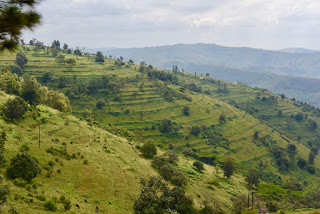 The roads
The roadsare excellent and winding, going up and up, higher and higher, and I thought,
Barry Haarde just has to do Wheels for the World in Rwanda! And sure enough, we
pass impressive, ripped Rwandans cycling up these killer mountains, wearing
professional gear. Jaw-dropping power!
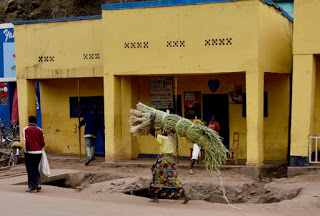 They, like
They, likeus, pass by hundreds of people walking. Everyone in Rwanda walks. Children
struggle with big yellow containers holding water. Old women balance primary
color buckets on their heads, filled with potatoes to sell. Women, men and
children sway under 20-foot tree trunks, sometimes as many as five on one
person, to bring home to chop into firewood. Most people don’t have cars, or
running water. So water and fuel for the fire must be sought or bought and
carried home. Mile after mile, men push bicycles up these hilly roads, which
are laden with several enormous sacks of potatoes. We drive by one bicycle
which only had tires visible; the entire bike and rider, pushing it, was engulfed
in a mountain of kindling. No one hitches for a ride. Everyone is working. By
noon we see impeccably dressed people in large groups walking along: Seventh
Day Adventists returning from church. How handsome they all look, in contrast
to the dusty roads. Faustin pulls the car over and we get quizzical stares, but
he introduces me to his father, in one of the groups. Expressions change to
greetings of joy.
Kivu, and “Paradis Malahide,” my mid-range hotel. It’s fine with me, quite
nice. It has a Caribbean feel to it. We check in, and two smiling Masaai
promptly approach and ask if I want to buy sandals.
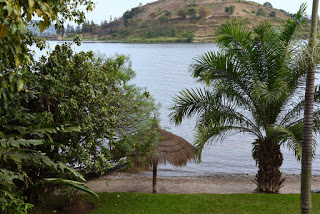 My room is up on the second floor, all wood, with a beautiful view of Lake Kivu. I
My room is up on the second floor, all wood, with a beautiful view of Lake Kivu. Iinstantly want to just curl up with my book on Rwanda and relax. First lunch:
so we order and sit by the lake. We
eat lunch, which is an almost inedible sandwich for me. I don’t eat it all, as
the chicken slivers in it are dark meat, greatly overcooked. But Faustin
unabashedly takes whatever I have left and eats it, telling me that due to the
shortages of food in the country in the past, nothing goes to waste. He eats
everything in front of him.
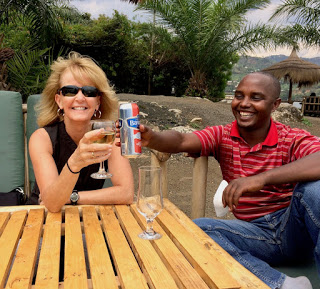 |
| Laurie Kelley and Faustin |
I ascend the
steps to my room, sort out my things, grab my iPad and read an excellent book
about President Paul Kagame, once leader of the rebellion to overthrow the
regime responsible for the genocide, and later president of Rwanda. A
fascinating man and leader. I order African tea, which is so delicious and
spicy, and watch as a sakabaka (black
kite) swoops down to the beach then back up again to a tree top. Then there are
two, doing a ritual dance, up and down, crisscrossing in the cloudless sky.
which maybe is the food least likely to be ruined by cooking (and I would know as I ruin everything I cook). It’s fine, but
too much, and I eat only half the dish and half a glass of wine. I return to my
room, roll down the mosquito netting and read till I fall asleep, serenaded by
the whirring of the crickets and occasional bird calls.
ready by 7 am, as planned, with no breakfast. Just a take-out order of bread
and bananas. We head for
the Rwandan border. Rwanda customs is in a huge building, very out of place in this
remote area. It’s cavernous, empty and air conditioned. Gleaming floors and an
efficient process for passing to the Democratic Republic of the Congo (DRC). We
wait in line, get a stamp, and done!
We then walk across the border, showing our
passport and stamps to the agents seated in the searing sun. As soon as we walk
across the border, the quality of life plummets. It’s an incredible contrast to
the pretty streets of Rwanda. Both are poor countries; both have dusty roads
and homes of rock with corrugated metal roofs. The main difference is that
Rwanda is kept clean: no trash anywhere. In the DRC, people toss wrappers and
trash at their feet. In Rwanda in the
morning, you will see women with their home made brooms of corn husks or branches,
sweeping out the streets, of any stray paper or even dried leaves… even far
away from Kigali on the main road to the DRC, these city workers are sweeping
up fallen leaves from the trees that landed on the road side! Not in the DRC.
It is an impoverished country, psychically and mentally.
good bye as he returns to Rwanda on foot. I climb into the new jeep and away we
go to Mt. Nyiragonga, a large active volcano. My guide, Tresor, can’t wait to
tell me about the DRC. We are now in Goma, a town made famous during the 1994
genocide, into which a huge number of Hutu refugees flowed after the Tutsi massacre
stopped. They crushed this town, and created one of the worst humanitarian
crises of our times. It was only then, when cholera swept through the camp,
killing thousands and orphaning thousands, that the West finally sat up and
noted that Rwanda had a few problems. That’s a story for another time but the
history of Rwanda and its genocide is absolutely fascinating; I’m reading my
fourth book about it.
a man pushing a chukudu, a two-wheel
wooden “motorcycle,” and Tresor explains that this statue, erected in 2009, is
the symbol of the DRC, and how hard its people work. That’s true: everyone is
working. There are no beggars in such a place, as tourism is limited. I find
you mostly have beggars when there is an influx of tourists.
buildings and even the color of the people, is chalky, dusty grey. Partly it is
from living in lava-land. The last eruption of Nyiragonga was in January 17, 2002,
when the lava lake collapsed, and lava sped at 60 mph (the fastest ever
recorded!) and reached Goma, coating everything in molten rock, which hardened
to a shell. About 147 people died, and 120,000 were left homeless. An ongoing
threat, besides the rumblings of this active volcano, is carbon dioxide
emissions from the ground, called mazuku,
which kills, as recently as 2016.
lava rock, home built of lava rock, and the color charcoal grey.
grey gives way to red dust, as we drive along the main road to the national
park. Within 20 minutes we arrive. A group of men shuffle their feet in place
along the roadside, perhaps waiting to be chosen as porters for the mzungu (white person) who will ascend the volcano
today. The driveway to the registration cabin is so steep we have to get out
and walk, so the jeep can make it up. Welcome to La-Va Land!
about 30 minutes to sign in, and wait for the rest of our group. We have only
a few people in our group, and indeed, only a few can go at a time. First, it’s
dangerous and a strenuous hike. Second, at the rim of the volcano, where we
will camp overnight, there are only a few sheds (A-frames made of metal). Our
group? George, an FBI agent working in Nigeria, and a dead ringer for Tom
Brady. Orlando, a very athletic flight attendant with Edelweiss Air in Switzerland.
And Franziska and Bacadi, a 30-year-old German woman and her Zanzibarian
boyfriend. This was a great group to hike with and with a few porters (mine is
Josef, who will carry my duffel bag), Tresor and two armed rangers, we head
out!
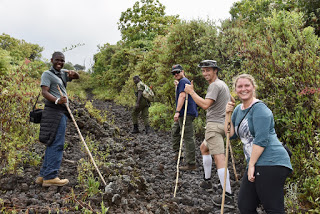
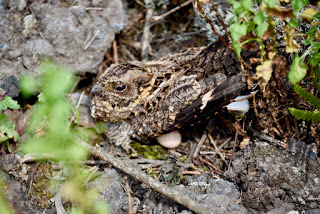
overall a very strenuous hike, more
than I imagined. Despite being in pretty good shape, I found it hard. In less
than a year, I’ve summited Kilimanjaro (a 6-day hike, 19,341 ft), and then Everest
base camp (9 day, 17,500 ft) but this 11,380 footer was a killer! Partly it’s
the 45° angle that strains the quads and calves; partly it’s the loose lava
rocks. At times you ware walking on wet ground; at others, on loose lava scree;
then you will walk on rocks that twist ever which way and are as sharp as
razors. And there’s the altitude. We were all huffing and puffing our way up,
quads screaming at times. And we need to ascend quickly. Up straight to the
top; sleep overnight, then descend first thing in the morning.
and I fell in to talking: she and Bacadi work at a hotel in Zanzibar (one of my
favorite places to visit!). She speaks several languages, but he! He speaks
Swahili, English, German, Italian, French and is learning Spanish! And he was
such a nice guy. I admired how kind he was to his girlfriend. Franziska
struggled right from the start. She was nervous as her fitness level was
self-admittedly not high. I tried to reassure by saying it’s not a competition;
we are in no rush. We’ll all wait. And also what I have in fitness is negated
by age! After all, I’m almost twice as old as her.
was a slow hike, with Franziska asking childlike at each rest stop, How much
longer till the next stop?
we went up, the quieter the group became, as we focused on not twisting our
ankles, and breathing deeply. The air was moist, the vegetation thick and rich.
Tresor stopped us on one rocky section to look at something amidst the rock
piles. I saw nothing. It’s a bird! He said. I didn’t see it. Finally, its form
emerged out of the rocks, like a 3-D photo in which you have to blur your eyes
to see the picture. It was a nightjar, sitting quietly, blinking in the sunlight. I
thought it injured, but when Foramen, our guard, touched it with his gun tip,
the bird arched its wings to ward us off, and there underneath it, warm and
safe, was a single white egg. After a quick snap of the camera, we trudged on.
the moist forest gave way to an alpine climate, with low scrub brush and trees
similar to those I’ve seen on Kilimanjaro. The air grew very cool and
we donned jackets. The hillside became even more rocky, in fact, all rocks now.
Sometimes you could find where the spilled lava river solidified, and you felt
like you were walking on a smooth river of stone. Then it changed to sharp,
black, porous lava. Our feet, stepping and kicking them, caused a tinkling
sound, like crystal. Despite its menacing look, the lava sounded like the
finest Waterford.
reached our goal, the summit of Nyiragonga, 11,384 feet! Clouds moved in,
sometimes obscuring our view. All of us were anxious to see the famed lava
lake. We ditched out backpacks, threw on extra layers and climbed up a few more
feet to perch on the rim. And I mean perch. It’s a sheer drop down into the
volcano, at the bottom of which is a red, thick, ever-shifting lake of lava, complete
with red waves, red flames shooting upward, bubbling molten rock. It’s like a
prehistoric vision of what hell might be like. If I were an uneducated person,
living centuries ago, this would awe and frighten (it still does) and I would
believe that this is Hell, literally. It looks like the doorway to the Underworld,
where people would burn in its fire for eternity.
just a volcano. And a magnificent one.
the longest time, mesmerized, silent except for some oohs and ahhs. Clouds came
and went, but finally they parted to give us a good view of the lake. To hold
my cameras still, I crouched down on the lava, which was mighty uncomfortable;
lava is razor-sharp and hurts. After about 30 minutes of trying to think of
poetry or words that could do this vision justice, I groped my way to my metal
tent. Inside was just a bare mattress, onto which I threw my wonderfully warm
sleeping bag and my gear. I brought a headlamp, essential, and all the usual accessories.
I added layers and layers as it was cold, about 40°. Not freezing, but still I
could see my breath. Dinner was called and we fumbled our way on the pitched
slope in the dark to the mess tent, which had a charcoal fire on the ground. The air was nearly unbreathable inside. Tresor asked me if we used charcoal back home.
and dirty, unlike my other adventure trips. The food wasn’t particularly good, especially
inedible was the chicken. Franziska and Bacadi joined us; they signed up for
this on a whim and were fairly unprepared! No gloves and no food. We had them
eat ours, gladly, as I ate almost nothing. Then back to bed where I read a bit
before falling into a deep sleep.
at 4 am, happy and content to be on this dirty volcano, and didn’t even need a
second look at the lava lake (which was obscured by clouds I later learned). I
wanted to get back to Kigali for my 7:30 pm flight, a long ways away. So I was
ready—even had mascara and eye liner on!—and after a quick bite we started
down.
ached and my knees buckled from the 7-hour hike yesterday, and minimal food and
nutrients. I actually had to be careful using my left knee so I didn’t wrench
it. Going downhill on loose lava at a 45° angle is tricky. I slipped a few
times, fearful of landing in the mud (the overnight moisture softened all the earth and
made the rocks slippery) so Foramen held his hand out to me often to help me.
It was a long, quiet three-hour hike back to base. But as we descended towards
the end, I heard a whoop and a rush, and Franziska flew past me and grabbed Foramen!
Get me off this mountain! she happily squealed! I teased her that she was
fooling us about her fitness level. She actually felt good while I was trashed!
we exchanged email addresses, waved good-bye, and got into our jeeps to head
for home. I tried to hurry Tresor, but he assured me that we had plenty of
time. And he was right. About 30 minutes later, I walked across
the border into Rwanda again with Tresor, who left me in the hands of Chris, my
drive back to Kigali.
and after a 30-minute drive I climbed into the back seat to try to sleep before
the long trip home. After an hour I gave up and climbed back into the front
seat. Chris and I chatted. I told him I had used Gorilla Trek Africa three
years ago to find gorillas in Rwanda and I loved my guides, who were so good, I
decided to use the outfitter again. He asked who they were: Scodius (who is
friends with me on FB) and a young guy whose name I don’t recall… Chris was
silent then said quietly, That was me.
And he laughed and laughed and I felt all barriers falling. Now I recall!
dine with me in the dining room, instead of having them go back to the lesser quality guides’
hotel. We sang Christian songs all the way back to Kigali, I recall, and Chris
gave me a CD with all the songs on it. So this was really nice to see him again and connect.
how he was born in the jungle, and called himself “Son of Gorillas.” His mother
couldn’t get to the hospital or even midwife; she had been out collecting
firewood, and so she gave birth right in the jungle! To cut the umbilical cord,
one of the women she was with said to bite it. No one would bite it! You do it,
you do it, they all shouted at each other. Then finally they sharpened the edge
of a fan palm, which is tough and sharp anyway, and they cut it. Twelve kids
later, they all kid Chris about being the “son of a gorilla.” Chris became
sober when I asked about his mother now: killed in the genocide, along with a
sister. There’s just no escaping the genocide impact on this country.
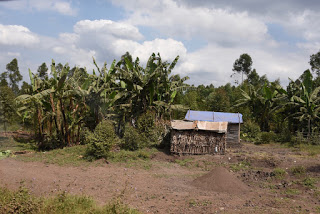 We stopped
We stoppedat a convenience store and bought muffins, which I promptly dropped in the dirt
on the roadside, but ate anyway, after dusting it off. I am getting way too chancy in my habits overseas!
Kigali, to the Mille Collines, which kindly lent me a room for one hour to
shower and repack, and then Chris brought me to the small international airport. We had to
stop at the airport entrance, unload all the luggage and a Belgium malnoir sniffed
through everything. (Rwanda has tight security.)
that. I tipped Chris, gave him a hug, settled at a coffee shop in the brilliant sunshine,
and waited for my flight. Eventually it would be a 7:40 pm flight to Nairobi
with a 2-hour layover, a 7.5 hour flight to Amsterdam, with a three hour
layover, and a 7.5 hour flight to Boston.

